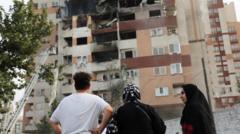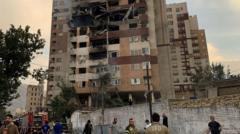An analysis of recent Israeli strikes shows that Iran's network of militias, known as the "Axis of Resistance," has been significantly weakened over the past year, with key players like Hezbollah failing to respond assertively to Israeli aggression.
Israel’s Airstrikes Highlight Weakness in Iran’s Network of Militias

Israel’s Airstrikes Highlight Weakness in Iran’s Network of Militias
Rising tensions in the Middle East reveal the diminishing strength of Iranian proxies like Hezbollah in response to Israeli military actions.
The recent Israeli airstrikes on Iran illustrate a pivotal moment in Middle Eastern dynamics, particularly concerning Iran's established network of militant proxies known as the "Axis of Resistance." For over forty years, Iran has invested considerable resources in building this coalition, forming a strategy designed to combat Israel and safeguard its interests in the region.
However, recent assessments indicate that this military alliance has suffered substantial degradation. Experts highlight that following a series of strikes on Iranian positions last Friday, many anticipate a muted response from these militant groups, contradicting their previous readiness to engage militarily.
Notably, Hezbollah, Iran's most formidable proxy, issued a condemnation of the Israeli airstrikes but notably refrained from promising any military retaliation. This hesitation marks a significant shift for a group that has traditionally been viewed as a key player in the Axis of Resistance, often leading the charge against Israeli forces.
Mohanad Hage Ali, a senior fellow at the Carnegie Middle East Center, summarized the current state of the Axis, stating, "It has been transformed into an axis of sitting ducks… rather than taking initiative and pushing Israel into the defense, as was the case just a few years ago." Such observations shed light on how the balance of power in the region is shifting.
Iran developed this network of militant groups, which includes Hamas, the Houthis of Yemen, and various Iraqi militias, with the dual purpose of enabling direct attacks on Israel and securing allies that could deter potential Israeli offensives against Iran itself. Nevertheless, the aggressive military actions launched by Israel over the past year—targeting these militias in Lebanon, Syria, Yemen, and Iran—have left many of these groups increasingly incapacitated.
A notable case is Hezbollah, which found itself severely weakened following its extended conflict with Israel. This devastating war not only obliterated much of Hezbollah's leadership but also left Lebanon with an enormous reconstruction debt. The aftermath has sparked growing dissatisfaction among the Lebanese public towards Hezbollah, who are now attributing blame for the country's catastrophic engagement in deadly hostilities.
As the geopolitical landscape continues to evolve, the ramifications of these changes in the Axis of Resistance present significant implications for regional stability and security moving forward.
However, recent assessments indicate that this military alliance has suffered substantial degradation. Experts highlight that following a series of strikes on Iranian positions last Friday, many anticipate a muted response from these militant groups, contradicting their previous readiness to engage militarily.
Notably, Hezbollah, Iran's most formidable proxy, issued a condemnation of the Israeli airstrikes but notably refrained from promising any military retaliation. This hesitation marks a significant shift for a group that has traditionally been viewed as a key player in the Axis of Resistance, often leading the charge against Israeli forces.
Mohanad Hage Ali, a senior fellow at the Carnegie Middle East Center, summarized the current state of the Axis, stating, "It has been transformed into an axis of sitting ducks… rather than taking initiative and pushing Israel into the defense, as was the case just a few years ago." Such observations shed light on how the balance of power in the region is shifting.
Iran developed this network of militant groups, which includes Hamas, the Houthis of Yemen, and various Iraqi militias, with the dual purpose of enabling direct attacks on Israel and securing allies that could deter potential Israeli offensives against Iran itself. Nevertheless, the aggressive military actions launched by Israel over the past year—targeting these militias in Lebanon, Syria, Yemen, and Iran—have left many of these groups increasingly incapacitated.
A notable case is Hezbollah, which found itself severely weakened following its extended conflict with Israel. This devastating war not only obliterated much of Hezbollah's leadership but also left Lebanon with an enormous reconstruction debt. The aftermath has sparked growing dissatisfaction among the Lebanese public towards Hezbollah, who are now attributing blame for the country's catastrophic engagement in deadly hostilities.
As the geopolitical landscape continues to evolve, the ramifications of these changes in the Axis of Resistance present significant implications for regional stability and security moving forward.





















